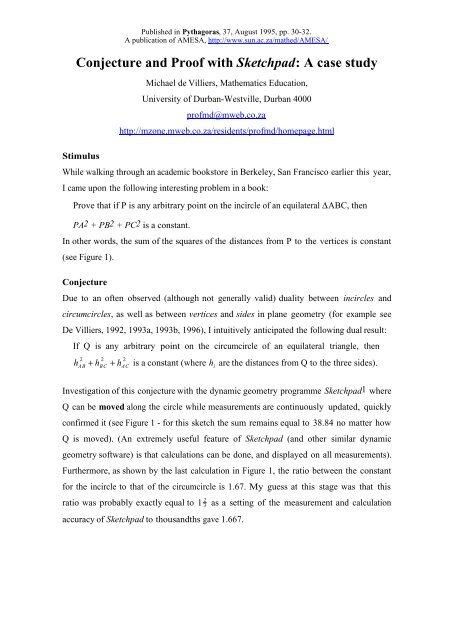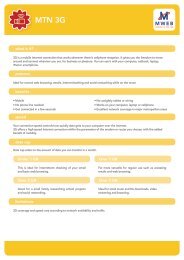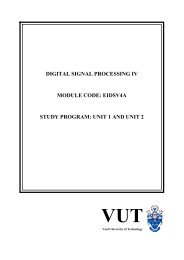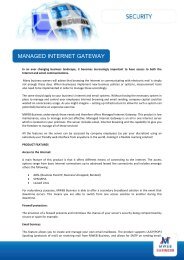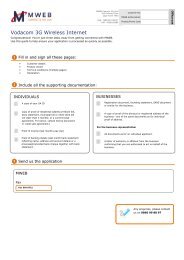Conjecture and Proof with Sketchpad: A case study - Mweb
Conjecture and Proof with Sketchpad: A case study - Mweb
Conjecture and Proof with Sketchpad: A case study - Mweb
Create successful ePaper yourself
Turn your PDF publications into a flip-book with our unique Google optimized e-Paper software.
Published in Pythagoras, 37, August 1995, pp. 30-32.A publication of AMESA, http://www.sun.ac.za/mathed/AMESA/<strong>Conjecture</strong> <strong>and</strong> <strong>Proof</strong> <strong>with</strong> <strong>Sketchpad</strong>: A <strong>case</strong> <strong>study</strong>StimulusMichael de Villiers, Mathematics Education,University of Durban-Westville, Durban 4000profmd@mweb.co.zahttp://mzone.mweb.co.za/residents/profmd/homepage.htmlWhile walking through an academic bookstore in Berkeley, San Francisco earlier this year,I came upon the following interesting problem in a book:Prove that if P is any arbitrary point on the incircle of an equilateral ∆ABC, thenPA2 + PB2 + PC2 is a constant.In other words, the sum of the squares of the distances from P to the vertices is constant(see Figure 1).<strong>Conjecture</strong>Due to an often observed (although not generally valid) duality between incircles <strong>and</strong>circumcircles, as well as between vertices <strong>and</strong> sides in plane geometry (for example seeDe Villiers, 1992, 1993a, 1993b, 1996), I intuitively anticipated the following dual result:If Q is any arbitrary point on the circumcircle of an equilateral triangle, then2h AB2+ h BC2+ h ACis a constant (where h iare the distances from Q to the three sides).Investigation of this conjecture <strong>with</strong> the dynamic geometry programme <strong>Sketchpad</strong>1 whereQ can be moved along the circle while measurements are continuously updated, quicklyconfirmed it (see Figure 1 - for this sketch the sum remains equal to 38.84 no matter howQ is moved). (An extremely useful feature of <strong>Sketchpad</strong> (<strong>and</strong> other similar dynamicgeometry software) is that calculations can be done, <strong>and</strong> displayed on all measurements).Furthermore, as shown by the last calculation in Figure 1, the ratio between the constantfor the incircle to that of the circumcircle is 1.67. My guess at this stage was that thisratio was probably exactly equal to 1 2 3 as a setting of the measurement <strong>and</strong> calculationaccuracy of <strong>Sketchpad</strong> to thous<strong>and</strong>ths gave 1.667.
Distance Q to a = 5.58 cmDistance Q to b = 1.61 cmDistance Q to c = 2.25 cm(Distance Q to a) 2 2 2 2+ ( Distance Q to b) + ( Distance Q to c) = 38.84 cmPA = 5.75 cmPB = 2.16 cmPC = 5.20 cmPA 2 + PB 2 + PC 2 = 64.74 cm 2AQcbPBaCPA 2 + PB 2 + PC 2(Distance Q to a) 2 + ( Distance Q to b)2 + ( Distance Q to c)2= 1.67Figure 1Investigate these theorems dynamically <strong>with</strong> the use of <strong>Sketchpad</strong>!1. If you do not have <strong>Sketchpad</strong>, first download a FREE DEMO of it from:http://www.keypress.com/sketchpad/sketchdemo.html2. Then download the following to dynamically investigate these theorems:http://mzone.mweb.co.za/residents/profmd/conject.zip<strong>Proof</strong> of first resultConsider Figure 2 where the equilateral ∆ABC has been placed <strong>with</strong> itsincentre/circumcentre at (0;0). Without loss of generality, let A( 0; 2a ), B( − 3a; − a ),C( 3a; − a ) <strong>and</strong> P( x; y ). Then the incircle is x 2 + y 2 = a 2 <strong>and</strong> PA 2 + PB 2 + PC 2
Published in Pythagoras, 37, August 1995, pp. 30-32.A publication of AMESA, http://www.sun.ac.za/mathed/AMESA/= [ x 2 + (y − 2a) 2] + [(x + 3a) 2 + (y + a) 2] + [(x − 3a) 2 + (y + a) 2]= 3(x 2 + y 2 ) +12a 2= 3a 2 +12a 2= 15a 2Since a is constant, it follows that the sum of the squares of the distances from P to thevertices must also be constant.yA2aQOx2aPa2aBCFigure 2<strong>Proof</strong> of conjectureTo prove this conjecture, one needs to know (or deduce) what the squared distance isfrom a point (p;q) to a given line y = mx + c, which is given as:⎛p −⎝mq + p − cmm 2 +1⎞⎠2⎛+ ⎜ q − c + m 2 p + mp ⎞⎝ m 2 +1 ⎠2If we consider the same triangle as in Figure 2, then the circumcircle is x 2 + y 2 = 4a 2 , ABis y = 3x + 2a , AC is y = − 3x + 2a <strong>and</strong> BC is y = −a . Then using the above result2 2 2we have h AB+ h BC+ h AC
⎛= ⎜ x −⎝3y + x − 2 3a⎞⎟4 ⎠2⎛+ ⎜ y −⎝2a + 3y + 3x42⎞⎟⎠+ ( x − x ) 2 + ( y − (−a)) 2 + ⎜ x −⎛⎝− 3y + x + 2 3a42⎞⎟⎠⎛+ ⎜ y −⎝2a +3y − 3x4= 3a 2 + 3 (2 x 2 + y 2)= 3a 2 + 3 2 × 4a 2= 9a 2⎞⎟⎠2Since a is constant, it follows that the sum of the squares of the distances from Q to thesides must be constant. Furthermore, the ratio of these two constants can now clearly beseen to be 15a2/9a2 = 5 3 = 1 2 3 = 1.67.Looking backAlthough I knew from the very beginning that the first result was obviously true(otherwise why ask to prove it), he did not know beforeh<strong>and</strong> whether the dual conjecturewas true or not. Now given such a situation where no outside authority (a book, article orcolleague) tells one in advance that a particular result is true or false, what is one to do?It would seem that either one must first explore it experimentally by making someconstructions (for which a programme like <strong>Sketchpad</strong> is ideally suited) or one mustimmediately try to construct a proof. However, if the proof is not a simple straightforward matter (as was the <strong>case</strong> here), it seems far more sensible to first checkexperimentally whether something is really true before one embarks on the possibly toughjourney of trying to prove it. (If it is false, your experimental exploration will hopefullyproduce a counter-example, saving you valuable time in trying to unsuccessfully prove it).Conviction is often a prerequisite for proofContrary to the traditonal teaching approach where proof is only presented as aprerequisite for conviction, we actually see from the above, that conviction is frequently a
Published in Pythagoras, 37, August 1995, pp. 30-32.A publication of AMESA, http://www.sun.ac.za/mathed/AMESA/prerequisite for proof. In a research situation one would certainly not try to prove a resultwhich seems rather doubtful, <strong>and</strong> one would only attempt a proof once one has satisfiedoneself that it seems reasonable.The educational implications of the above are many. Firstly, the traditionalapproach tends to give the false perception that new mathematics is only discovereddeductively, <strong>and</strong> that experimentation is taboo in (real) mathematics. Secondly, in thetraditional approach pupils have no ownership over results since the teacher, textbook<strong>and</strong>/or syllabus are seen as the ultimate authorities dictating, not only the choice ofresults, but their validity as well.It would seem that the only way to change this is to actually involve pupils in theprocesses of mathematical discovery <strong>and</strong> proof in a research type setting. This wouldmean designing learning activities which allow for experimental exploration, conjecturing,refuting, formulating <strong>and</strong> reformulating, as well as explaining (proof). In this situation theteacher's role must then obviously change from that of an authority to that of a facilitatorof learning, allowing pupils to take ownership <strong>and</strong> responsibility for their ownmathematical development.Of course, any experimental exploration (e.g. construction <strong>and</strong>/or calculation) byh<strong>and</strong> is extremely tedious. Furthermore, such pencil <strong>and</strong> paper work is quite oftenrelatively inaccurate <strong>and</strong> one could fail to see an important underlying pattern or observean important counter-example. It therefore necessitates the use of appropriate technologyin the classroom such as scientific <strong>and</strong> graphic calculators or computer programmes like<strong>Sketchpad</strong>, Cabri or Cinderella.Note1 In South Africa, <strong>Sketchpad</strong> is available from Dynamic Math Learning, 8 Cameron Rd,Pinetown, 3610. Tel: 031-7083709 or 031-7029941 (Pearl de Villiers). Cell: 082-2295103(Pearl de Villiers) e-mail: dynamiclearn@mweb.co.zaReferencesDe Villiers, M. (1992). Using duality in the discovery of some new results.Mathematical Digest, 89, 4-8.
De Villiers, M. (1993a). Revisiting the duality between incentres <strong>and</strong> circumcentres.Mathematical Digest, 91, 4-6.De Villiers, M. (1993b). A unifying generalization of Turnbull's theorem. Int. Journ.Math. Ed. Sci. & Technol, 24(2), 191-196.De Villiers, M. (1996). Some Adventures in Euclidean Geometry. University ofDurban-Westville.Mathematical Digest = http://www.mth.uct.ac.za/~digest/International Journal of Mathematical Education in Science & Technology =http://mamch-mac.lboro.ac.uk/ijmest.htmlXXXXXXXXXXX"... computer graphics refreshes a distinction between fact <strong>and</strong> proof, one that manymathematicians prefer not to acknowledge but that Archimedes describedwonderfully in these words: 'Certain things first became clear to me by amechanical method, although they had to be demonstrated by geometry afterwardsbecause their investigation by the said mechanical method did not furnish an actualdemonstration. But it is of course easier, when the method had previously given ussome knowledge of the questions, to supply the proof than it is to find it <strong>with</strong>outprevious knowledge. This is a reason why, in the <strong>case</strong> of the theorems that thevolumes of a cone <strong>and</strong> a pyramid are one-third of the volumes of the cylinder <strong>and</strong>prism (respectively) having the same base <strong>and</strong> equal height, the proofs of whichEudoxus was the first to discover, no small share of the credit should be given toDemocritus who was the first to state the fact, though <strong>with</strong>out proof'."- Benoit M<strong>and</strong>elbrot (1992: 88) Fractals, the Computer <strong>and</strong> Mathematics Education.Proceedings of ICME-7, Quebec, Canada.


